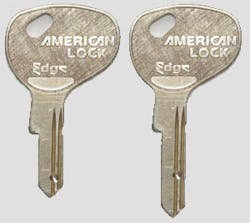American Lock introduces its patent pending Key Control product for door hardware compatible cylinders. Initially, three types of cylinders are offered; Rim, Mortise and Cylindrical. They have been tested to and passed Grade 1 requirements under ANSI/BHMA 156.5.
While this patent pending key control is a new offering for American Lock, it has been available for a couple of years from Master Lock as the ML® System. First seen at the ALOA product exhibition in July, distributor orders started shipping in August.
American has offered rim and mortise cylinders with multiple keyway options for years. Now, the company is adding cylindrical lock cylinders with the Lori 1539 interface.
These products will also be supplied with a different key than the one used in the padlock cylinders. The new keys will be nickel-silver and have the larger bow shown here. Because these cylinders will be installed in door locks and likely to be subjected to more stress, American chose to use a stronger key. Since the actual keyway is the same as used in padlock cylinders, the only option was to change to a stronger material. The keys are available with a four-pin or a six-pin length and may be ordered by using the part numbers AWP4 and AWP6 respectively. The same contractual restrictions apply for purchasing product or key blanks and can be ordered through your participating distributor.
The mortise cylinders have some special features. First, they are all six-pin cylinders, even the 1” mortise cylinder. This is possible because they use the same .397” plug diameter and pin chamber spacing as a Master padlock cylinder. The exploded view shows the hardened pins installed for drill resistance. These cylinders were tested for compliance with the drill resistance portion of the UL437 standard and exceeded all requirements. Hardened pins on each side of the keyway in the plug,protect the pin stack in the shell. For an extra measure of security against drilling there is a hardened pin in front of each mounting slot for the mortise set screw. The pin chambers have set screws instead of caps or a curved cover. This is primarily to prevent a comb attack.
The last special feature is the oversized plug head. At least it’s oversized for the .397” diameter plug, but esthetically it looks just like any other mortise cylinder from the front. Standard measurement from the back of the head to the back of the cam yields three lengths that are available. The 1”, 1 1/8” and 1 1/4” have part numbers that reflect the size. The M100 is the one-inch version, the M112 is the 1-1/8” version and the M125 will get you the 1-1/4” version. Three standard finishes are available, US3, US10B and US26D.
There are some mounting differences for the cams and tailpieces on the EDGE cylinders. The location of the ball bearings for some virtual keyways requires that a single screw method of mounting the cam be used for the mortise cylinders. All of the EDGE mortise cylinder cams will have a single screw mount. Six cams are being offered initially. They are shipped 10 each in a bag.
The rim cylinder uses the same shell as the 1 1/8” mortise cylinder but with a different plug. The rim cylinder plug allows the tailpiece to be installed as either vertical or horizontal. A third lost motion tailpiece is also available. It has the same drill protection as the mortise cylinder and the same finishes are available.
The cylindrical version has the same exact external dimensions as the popular Lori 1539 replacement cylinder and comes with the same three types of tailpiece. Available as either US3 or US26D finish, the plug head is typical for this type of cylinder but with the .397” diameter for the plug.
This cylinder has anti-drill pins on each side of the keyway and uses the same set screws in the pin chambers as the rim and mortise versions.
The plug is retained in the shell via an E-clip and the tailpiece has a wire retainer to slip it in or out of position. Rekeying may be accomplished via the set screws in each pin chamber, or you can use the new follower, part number 296-60612.





